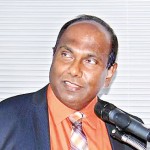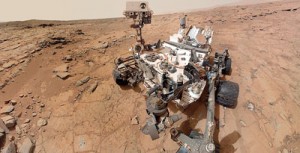A shining light to Lanka’s budding scientists
Two things are clear -Dr. Sarath Gunapala is a local celebrity and no one is more surprised than he to find this is so. Last week, an eager audience left only standing room in the small auditorium at the American Center, as they crowded in to hear a lecture by the Director of the Center for Infrared Photodetectors at NASA’s Jet Propulsion Laboratory (JPL) in Pasadena, USA.

This near-infrared, colour view from Cassini shows the sun glinting off of Titan’s north polar seas. Image credit: NASA/JPL-Caltech/Univ. Arizona/Univ. Idaho
The crowd gathered to hear about the ongoing exploration of the Solar System was a diverse one – ranging from elderly space enthusiasts to children still in their school uniforms – and a majority lingered, queuing up to claim an autograph and to pose for photos. In fact, he was so much in demand that for this post-lecture interview, Dr. Gunapala had to be cloistered in the children’s section of the library where he found himself a seat on a child-sized chair, and a place to rest his teacup on an enormous flower-shaped table top.
Even the closed door barely kept his fans at bay, with some stopping to peer through the glass front, clearly hopeful he intended to come out at once. Among the audience were boys from his old alma mater, Nalanda College. Several identified themselves as fledgling scientists, eager to know how they could follow in his footsteps. To do so, they would need to study physics with a practical bent, however with the caveat that it would be impossible to predict with any certainty what specialities would be in demand 10 years down the line at NASA. (Dr. Gunapala received his BS in Physics from the University of Colombo in 1979 and followed that with an MS and PhD in the same subject, both from the University of Pittsburgh.)

Captivating his audience: Dr. Sarath Gunapala at the American Center last Monday
Dr. Gunapala found his way to JPL via AT&T Bell Laboratories in 1992 where he was a member of the technical staff with an interest in infrared detectors – he remembers a team from NASA visited the labs the day his daughter was born, and as if that were a good omen, a job offer followed. Dr. Gunapala’s current research interests build on his early work, and focus on the creation of major infrared detectors and focal plane array initiatives for exceptionally complex and unique applications. As his resume reveals, over the last two decades his research into infrared imaging has been applied to enhancing night vision, medical diagnostics, service and maintenance applications, as well as Earth and planetary science remote sensing applications.
His successes have been recognised with multiple awards – notably in 2001, he was inducted into the United States Space Foundation Technology Hall of Fame. More recently in July 2013, he was honoured with an IEEE Aron Kressel Award (the highest award given by IEEE Photonics Society for the development of photonics devices)and the announcement that he was being made an IEEE Fellow (which recognises those who have made ‘extraordinary technical contributions over an extended period of time’) came later that same year.
The field Dr. Gunapala is doing his pioneering work in is rapidly advancing. Pierre Aigrain, the man who coined the term ‘photonics’ described it in 1967 as ‘the science of the harnessing of light. Photonics encompasses the generation of light, the detection of light, the management of light through guidance, manipulation, and amplification, and most importantly, its utilisation for the benefit of mankind.’ Speaking of the leaps in remote sensing technology based on photonics, Dr. Gunapala says: “That’s the only way to find life elsewhere. We can’t send spacecraft to these distant worlds, even travelling at the speed of light, it would take centuries.”
Dr. Gunapala’s work in photonics is based on infrared light – falling just outside the visible spectrum of light we can see with our naked eyes, infrared can nevertheless provide an astronomer with valuable insights. “NASA is interested in infrared because all the gases, the minerals, all the compounds in the universe, pretty much 99.9% of everything absorbs and emits in the infrared,” he explains. At JPL, Infrared analysis is used in remote sensing applications to study some of the most distant bodies and dust clouds in the universe even as it finds applications in military and medicine here on Earth.

NASA’s Curiosity Mars rover used the camera at the end of its arm in April and May 2014 to take dozens of component images combined into ‘selfie’ Credit: NASA/JPL-Caltech/MSSS
However, for astronomy buffs that afternoon the real reward was to hear Dr.Gunapala speak of SAM. The Sample Analysis at Mars is a suite of instruments on-board the rover Curiosity, which includes a laser designed by Dr. Gunapala’s team. Like everything else on Curiosity, SAM was designed to investigate whether the red planet did or ever had nurtured microbial life. “This was a very complex mission, we worked very hard on it,” says Dr. Gunapala, explaining that the rover had 10,000 components, only one of which failed in the field.
SAM’s instrument suite includes a Gas Chromatograph (GC), a Quadrupole Mass Spectrometer (QMS), and a Tunable Laser Spectrometer (TLS), as well as systems that manipulate and process samples. On Earth, it’s likely these would occupy an entire laboratory, but space is at a premium on Mars and the instruments have been miniaturised so that they occupy a space roughly the size of microwave oven inside the Curiosity rover.
SAM’s instruments have been used to analyse gases, either drawn directly from the atmosphere or extracted from powdered rock samples by heating or chemically treating the samples on site. However, while there’s plenty of evidence that water flowed on Mars, as clear in the pictures Dr. Gunapala shared, evidence to support the existence of microbial life is still missing, he says: “As soon as we got water on Earth, a simple form of life evolved, we have solid evidence in the form of fossils. So if Mars had running water, as we know from many experiments it did…and the temperatures were also nice, then it probably had some form of life. If there was life, then this life would have also produced methane as waste.”
Methane is a biogas – more than 90% of methane on our home planet is produced by living organisms. “Unfortunately, we couldn’t find any biological methane. Space exploration is sometimes frustrating,” says Dr. Gunapala. “We have to do more,” later he adds, “scientists haven’t given up on the possibility that life existed on Mars.”
NASA is already preparing for a second look, said Dr. Gunapala, discussing the Mars 2020 programme which will put a next-gen rover on the planet. NASA has announced that the new rover will carry more sophisticated, upgraded hardware as well as new instruments to conduct geological assessments of the rover’s landing site, determine the potential habitability of the environment, and directly search for signs of ancient Martian life.
Dr. Gunapala also spoke of proposals for exciting, new, big-budget ‘flagship’ space programmes that would enable NASA to explore the possibility of a liquid ocean under the icy crust of Jupiter’s moon Europa, and to examine the methane on the surface of Saturn’s largest moon Titan. The methane and ethane which pools in lakes, flows in rivers and forms deltas, and even evaporates and falls back to the surface as rain is uncannily similar to what we see on Earth with hydrogen.
For those rooting for a new generation of Sri Lankan scientists to be part of such explorations, this afternoon has been most encouraging – in particular how thick and fast the questions came. (To one in which an audience member suggested it might have been a bad idea to provide possibly hostile aliens with the coordinates to Earth, as had been recorded and placed aboard the interstellar mission Voyager, Dr. Gunapala replied: “Wow, that’s probably beyond my pay grade,” but went on to reassure his audience that aliens were unlikely to cross galaxies just to annihilate humanity).
Our interview has run on and we are still chatting as we leave the room to find that nearly an hour after the lecture concluded a family with a boy and girl is waiting patiently – both kids want pictures with Dr. Gunapala, who lays down his briefcase for the nth time and poses obligingly.
When asked about his early interest in science, Dr. Gunapala credited generous people around him who shared their knowledge with a curious child – his 8th grade teacher Mr. Jayasuriya who stayed after school to give him free coaching in chemistry or the world class scientists he heard deliver lectures at the Ceylon Astronomical Association (which coincidentally also regularly met at the American Center). It occurs to me now, watching him wait for the click of the camera’s shutter as he poses with the children, that in our audience today there was, with any luck, a future astronomer who will count this meeting with Dr. Gunapala as part of his or her inspiration to pursue a career in science. It seems only fitting really, that he should pass the torch.


